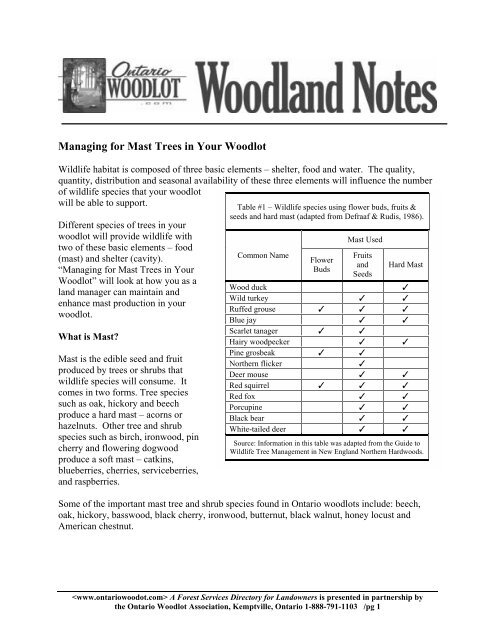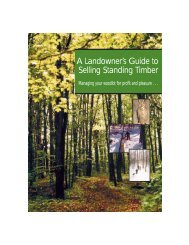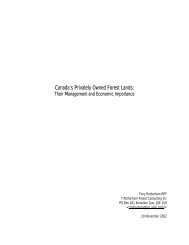Managing for Mast Trees in Your Woodlot - Ontario woodlot.com
Managing for Mast Trees in Your Woodlot - Ontario woodlot.com
Managing for Mast Trees in Your Woodlot - Ontario woodlot.com
You also want an ePaper? Increase the reach of your titles
YUMPU automatically turns print PDFs into web optimized ePapers that Google loves.
<strong>Manag<strong>in</strong>g</strong> <strong>for</strong> <strong>Mast</strong> <strong>Trees</strong> <strong>in</strong> <strong>Your</strong> <strong>Woodlot</strong><br />
Wildlife habitat is <strong>com</strong>posed of three basic elements – shelter, food and water. The quality,<br />
quantity, distribution and seasonal availability of these three elements will <strong>in</strong>fluence the number<br />
of wildlife species that your <strong>woodlot</strong><br />
will be able to support.<br />
Different species of trees <strong>in</strong> your<br />
<strong>woodlot</strong> will provide wildlife with<br />
two of these basic elements – food<br />
(mast) and shelter (cavity).<br />
“<strong>Manag<strong>in</strong>g</strong> <strong>for</strong> <strong>Mast</strong> <strong>Trees</strong> <strong>in</strong> <strong>Your</strong><br />
<strong>Woodlot</strong>” will look at how you as a<br />
land manager can ma<strong>in</strong>ta<strong>in</strong> and<br />
enhance mast production <strong>in</strong> your<br />
<strong>woodlot</strong>.<br />
What is <strong>Mast</strong>?<br />
<strong>Mast</strong> is the edible seed and fruit<br />
produced by trees or shrubs that<br />
wildlife species will consume. It<br />
<strong>com</strong>es <strong>in</strong> two <strong>for</strong>ms. Tree species<br />
such as oak, hickory and beech<br />
produce a hard mast – acorns or<br />
hazelnuts. Other tree and shrub<br />
species such as birch, ironwood, p<strong>in</strong><br />
cherry and flower<strong>in</strong>g dogwood<br />
produce a soft mast – catk<strong>in</strong>s,<br />
blueberries, cherries, serviceberries,<br />
and raspberries.<br />
Table #1 – Wildlife species us<strong>in</strong>g flower buds, fruits &<br />
seeds and hard mast (adapted from Defraaf & Rudis, 1986).<br />
Common Name<br />
Flower<br />
Buds<br />
<strong>Mast</strong> Used<br />
Fruits<br />
and<br />
Seeds<br />
Hard <strong>Mast</strong><br />
Wood duck<br />
✓<br />
Wild turkey ✓ ✓<br />
Ruffed grouse ✓ ✓ ✓<br />
Blue jay ✓ ✓<br />
Scarlet tanager ✓ ✓<br />
Hairy woodpecker ✓ ✓<br />
P<strong>in</strong>e grosbeak ✓ ✓<br />
Northern flicker<br />
✓<br />
Deer mouse ✓ ✓<br />
Red squirrel ✓ ✓ ✓<br />
Red fox ✓ ✓<br />
Porcup<strong>in</strong>e ✓ ✓<br />
Black bear ✓ ✓<br />
White-tailed deer ✓ ✓<br />
Source: In<strong>for</strong>mation <strong>in</strong> this table was adapted from the Guide to<br />
Wildlife Tree Management <strong>in</strong> New England Northern Hardwoods.<br />
Some of the important mast tree and shrub species found <strong>in</strong> <strong>Ontario</strong> <strong>woodlot</strong>s <strong>in</strong>clude: beech,<br />
oak, hickory, basswood, black cherry, ironwood, butternut, black walnut, honey locust and<br />
American chestnut.<br />
A Forest Services Directory <strong>for</strong> Landowners is presented <strong>in</strong> partnership by<br />
the <strong>Ontario</strong> <strong>Woodlot</strong> Association, Kemptville, <strong>Ontario</strong> 1-888-791-1103 /pg 1
Importance of <strong>Mast</strong><br />
In southern <strong>Ontario</strong>, over 75 species of birds and animals consume soft and hard mast from the<br />
various shrubs and trees found <strong>in</strong> your <strong>woodlot</strong>. The availability of mast is an important<br />
<strong>com</strong>ponent <strong>in</strong> ma<strong>in</strong>ta<strong>in</strong><strong>in</strong>g a healthy and reproductive wildlife population. Table #1 provides<br />
examples of some wildlife species found <strong>in</strong> central <strong>Ontario</strong> <strong>woodlot</strong>s and the type of mast used.<br />
Management Suggestions<br />
The follow<strong>in</strong>g suggestions are a few th<strong>in</strong>gs to keep <strong>in</strong> m<strong>in</strong>d when reta<strong>in</strong><strong>in</strong>g mast trees:<br />
Keep a m<strong>in</strong>imum of eight trees per hectare of mast-produc<strong>in</strong>g species measur<strong>in</strong>g >25 cm at<br />
breast height. To ensure successful poll<strong>in</strong>ation, the mast trees should be no further than 50 m<br />
apart.<br />
Bigger is not always better. The best mast trees to be reta<strong>in</strong>ed should be mature trees that have<br />
large, rounded, vigorous crowns. <strong>Trees</strong> with these characteristics generally produce more mast.<br />
The crown characteristics are more important to mast production than the diameter of the tree.<br />
Look <strong>for</strong> trees with evidence of previous use by wildlife. For<br />
example, a beech tree with bear claw marks or a bear’s nest present<br />
may be the most productive and consistent mast producer <strong>in</strong> that<br />
section of your <strong>woodlot</strong>.<br />
Figure #1: A bear’s nest found <strong>in</strong> a young beech tree. These nests are <strong>for</strong>med when<br />
bears break off branches <strong>in</strong> the upper crown of the tree while reach<strong>in</strong>g <strong>for</strong> mast<br />
(beechnuts).<br />
Hav<strong>in</strong>g knowledge of the biological features and silvicultural<br />
requirements of mast-produc<strong>in</strong>g trees is important <strong>in</strong> decisions<br />
concern<strong>in</strong>g wildlife management. Know<strong>in</strong>g the regeneration<br />
requirements of the species, <strong>for</strong> example, light tolerance and seedbed<br />
requirements, will assist <strong>in</strong> your ef<strong>for</strong>ts to regenerate the species <strong>for</strong><br />
future mast production.<br />
Knowledge of the tree’s fruit<strong>in</strong>g or seed<strong>in</strong>g habits provides valuable <strong>in</strong>sight to the availability<br />
and quantity of mast available to wildlife <strong>in</strong> your <strong>woodlot</strong>. For example, white oak flowers and<br />
bears fruit <strong>in</strong> one grow<strong>in</strong>g season, while red oak flowers and sets fruit <strong>in</strong> year one, although their<br />
acorns are not mature until the follow<strong>in</strong>g season. In addition, the frequency of seed crops<br />
between these two species is different. The seed crop period <strong>for</strong> white oak is four to ten years,<br />
and <strong>for</strong> red oak it is two to five years. Consider<strong>in</strong>g this <strong>in</strong><strong>for</strong>mation, where conditions permit, it<br />
would be wise to manage <strong>for</strong> mast trees <strong>for</strong> both white and red oak. <strong>Manag<strong>in</strong>g</strong> <strong>for</strong> both will<br />
lessen the opportunity of a mast failure <strong>in</strong> the same year, or <strong>for</strong> any extended period of time.<br />
A Forest Services Directory <strong>for</strong> Landowners is presented <strong>in</strong> partnership by<br />
the <strong>Ontario</strong> <strong>Woodlot</strong> Association, Kemptville, <strong>Ontario</strong> 1-888-791-1103 /pg 2
Re<strong>com</strong>mended Read<strong>in</strong>g<br />
Silvicultural Guide to <strong>Manag<strong>in</strong>g</strong> Forests <strong>in</strong> Southern <strong>Ontario</strong> – a copy of the guide can be<br />
obta<strong>in</strong>ed by call<strong>in</strong>g the <strong>Ontario</strong> M<strong>in</strong>istry of Natural Resources’ In<strong>for</strong>mation Centre at 1-800-667-<br />
1940 ($27.50).<br />
Guide to Wildlife Tree Management <strong>in</strong> New England Northern Hardwoods – a copy of this guide<br />
is available on the Internet at , or<br />
obta<strong>in</strong>ed by call<strong>in</strong>g (740) 368-0123.<br />
© 2003, <strong>Ontario</strong> <strong>Woodlot</strong> Association<br />
A Forest Services Directory <strong>for</strong> Landowners is presented <strong>in</strong> partnership by<br />
the <strong>Ontario</strong> <strong>Woodlot</strong> Association, Kemptville, <strong>Ontario</strong> 1-888-791-1103 /pg 3
















